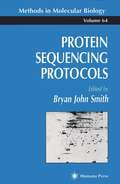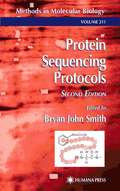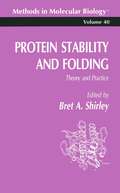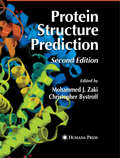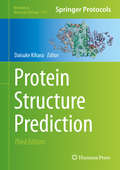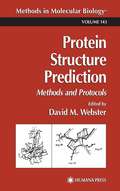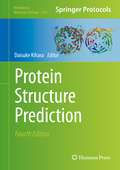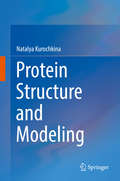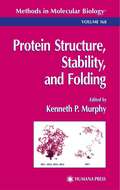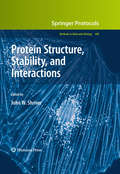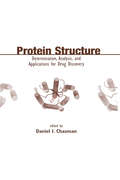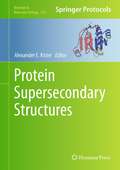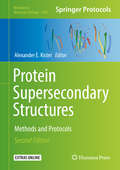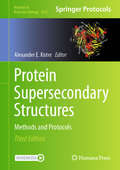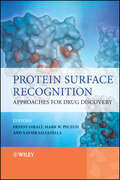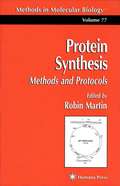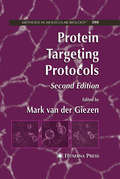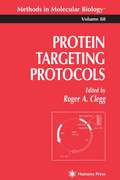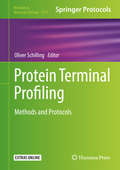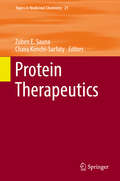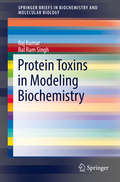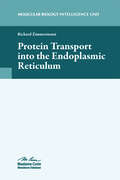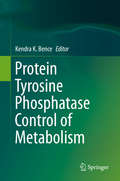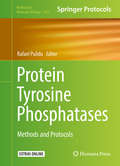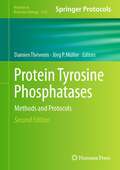- Table View
- List View
Protein Sequencing Protocols
by Bryan John SmithBryan Smith draws together in Protein Sequencing Protocols a timely collection of current and state-of-the-art techniques for protein and peptide preparation and sequencing-all described by hands-on masters of the procedures. These well-tested methods convey valuable lessons and insights into using automated sequencers and/or mass spectrometers, preparing proteins and peptides on a microgram and submicrogram scale, mapping peptides, analyzing amino acid by pre- and post-column derivatization methods, and sequencing N- and C-terminal peptides by classical and newly developed techniques. They also deal with such troublesome problems as identifying sites of modification and handling very small samples.<P><P> Protein Sequencing Protocols offers self-contained, step-by-step recipes that ensure easily reproducible results for those already doing sequencing, and for those who are still learning the methods, as well as for those already in one area but wishing to learn associated techniques. Its multiplicity of proven protocols will guide the challenged experimenter to successful results.
Protein Sequencing Protocols, 2nd Edition
by Bryan John SmithBryan John Smith updates his much-acclaimed first edition with new and updated techniques for determining the sequence of proteins and peptides. This edition includes not only novel approaches to the validation of quality assurance methods, reflecting the current importance of biopharmaceuticals, but also offers a guide to analysis of protein sequence information via the powerful new tools of bioinformatics. Comprehensive and up-to-date, Protein Sequencing Protocols, Second Edition, provides for both novice and expert investigators alike a ready source of easy-to-follow protocols that simplify choosing the most appropriate method for protein sequence determination.
Protein Stability and Folding
by Bret A. ShirleyIn Protein Stability and Folding: Theory and Practice, world-class scientists present in a single volume a comprehensive selection of hands-on recipes for all of the major techniques needed to understand the conformational stability of proteins, as well as their three-dimensional folding. The distinguished contributors provide clear, step-by-step instructions along with many troubleshooting tips, alternative procedures, and informative explanations about why certain steps are necessary. Even highly skilled researchers will find many time-saving methods. Among the techniques discussed are fluorescent, ultraviolet, and infrared spectroscopy; HPLC peptide mapping; differential scanning calorimetry; and hydrogen exchange. Shirley's Protein Stability and Folding: Theory and Practice will ensure a significant difference in the outcome of your experiments, producing the result desired even for beginners.
Protein Structure Prediction
by Chris Bystroff Mohammed ZakiThis book covers elements of both the data-driven comparative modeling approach to structure prediction and also recent attempts to simulate folding using explicit or simplified models. Despite the unsolved mystery of how a protein folds, advances are being made in predicting the interactions of proteins with other molecules. Also rapidly advancing are the methods for solving the inverse folding problem, the problem of finding a sequence to fit a structure. This book focuses on the various computational methods for prediction, their successes and their limitations, from the perspective of their most well known practitioners.
Protein Structure Prediction
by Daisuke KiharaProtein Structure Prediction, Third Edition expands on previous editions by focusing on software and web servers. With new chapters that provide instructions on how to use a computational method with examples of prediction by the method. Written in the highly successful Methods in Molecular Biology series format, chapters include introductions to their respective topics, lists of the necessary materials, step-by-step, readily reproducible protocols, and key tips on troubleshooting and avoiding known pitfalls. Authoritative and cutting-edge, Protein Structure Prediction, Third Edition provides diverse methods detailing the expansion of the computational protein structure prediction field.
Protein Structure Prediction
by David WebsterWorld-class investigators detail their most successful methods-and the theory behind them-for delineating the shape, form, and function of proteins. The protocols range from basic to advanced and include sequence alignment, the prediction of transmembrane protein structure, and the development of suitable folding potentials. There are also techniques for receptor site prediction, the identification of motifs and domains, the comparative modeling of proteins, the docking of peptides and ligands, and ab initio approaches to protein loop and side-chain prediction. Comprehensive, accessible, and highly practical, Protein Structure Prediction: Methods and Protocols offers protein researchers, structural biologists, and other investigators a critical synthesis of the latest research results, as well as the vital guidance needed to understand the structure and interaction of proteins and peptides.
Protein Structure Prediction (Methods in Molecular Biology #2165)
by Daisuke KiharaThis thorough new edition explores web servers and software for protein structure prediction and modeling that are freely available to the academic community. Taking into account the numerous advances in the computational protein structure prediction/modeling field, the book includes residue-contact prediction via deep learning, a wide variety of protein docking models, as well as cryo-electron microscopy (cryo-EM) techniques. Written by renowned experts in the field and for the highly successful Methods in Molecular Biology series, chapters include the kind of key detail and implementation advice necessary for researchers to achieve optimal results in their own work. Authoritative and fully updated, Protein Structure Prediction, Fourth Edition is a practical and immediately useful guide for biology researchers working toward modeling protein structures.
Protein Structure and Modeling
by Natalya KurochkinaThis book will consider principles of the organization of protein molecules, the relationships between primary, secondary, and tertiary structure, the determinants of protein conformation, and the applications of structure determination and structure modeling in biomedical research.
Protein Structure, Stability, and Folding
by Kenneth P. MurphyIn Protein Structure, Stability, and Folding, Kenneth P. Murphy and a panel of internationally recognized investigators describe some of the newest experimental and theoretical methods for investigating these critical events and processes. Among the techniques discussed are the many methods for calculating many of protein stability and dynamics from knowledge of the structure, and for performing molecular dynamics simulations of protein unfolding. New experimental approaches presented include the use of co-solvents, novel applications of hydrogen exchange techniques, temperature-jump methods for looking at folding events, and new strategies for mutagenesis experiments. Unique in its powerful combination of theory and practice, Protein Structure, Stability, and Folding offers protein and biophysical chemists the means to gain a more comprehensive understanding of some of this complex area by detailing many of the major techniques in use today.
Protein Structure, Stability, and Interactions
by John W. ShriverIn the areas of biochemistry and cell biology, characterizations of stability and molecular interactions call for a quantitative approach with a level of precision that matches the fine tuning of these interactions in a living cell. Supporting and up-dating previous Methods in Molecular BiologyTM volumes, Protein Structure, Stability, and Interactions approaches its subject with a focus on theory and practical applications for both established methods as well as exciting new procedures. The volume presents an overview of many techniques currently used to study protein stability and interactions, including scanning and titration calorimetry, spectroscopic methods, high field NMR, and analytical ultracentrifugation. As a volume of the highly successful Methods in Molecular BiologyTM series, this work provides the kind of detailed description and implementation advice that is crucial for getting optimal results. Cutting-edge and easy to reference, Protein Structure, Stability, and Interactions is an ideal guide for all scientists interested in biomolecular interactions.
Protein Structure: Determination, Analysis, and Applications for Drug Discovery
by Daniel I. ChasmanThis text offers in-depth perspectives on every aspect of protein structure identification, assessment, characterization, and utilization, for a clear understanding of the diversity of protein shapes, variations in protein function, and structure-based drug design. The authors cover numerous high-throughput technologies as well as computational met
Protein Supersecondary Structures
by Alexander E. KisterSuper secondary structure(SSS) helps to understand the relationship between primary and tertiary structure of proteins. In Protein Supersecondary Structure: Methods and Protocols expert researchers in the field detail the usefulness of the study of super secondary structure in different areas of protein research. This is done through four main studies SSS representation, SSS prediction, SSS and protein folding, and other application of SSS concept to protein biology. Written in the highly successful Methods in Molecular BiologyTM series format, chapters include introductions to their respective topics, lists of the necessary materials and reagents, step-by-step, readily reproducible laboratory protocols, and key tips on troubleshooting and avoiding known pitfalls. Authoritative and practical, Protein Supersecondary Structure: Methods and Protocols highlight some of the major advances in the many fast-growing areas of supersecondary structure research.
Protein Supersecondary Structures (Methods In Molecular Biology #932)
by Alexander E. KisterThis second edition volume expands on the previous edition with an update on the latest developments in the field and new techniques used to study secondary and supersecondary structures (SSS) in proteins. Chapters in this book discuss topics such as sequence and structural features of different SSS elements; software used for the automatic annotation of secondary structure elements in proteins; the new developments in secondary and SSS prediction and the modern approaches for energy landscape calculation; protein misfolding and amyloid structural formation; analysis of ‘transformer proteins’; discovery of the structure of the hydrophobic nucleus; and discussions of the main principles of protein structures formation. The contributing authors of the volume are the eminent experts in the field of protein research and bioinformatics. Written in the highly successful Methods in Molecular Biology series format, chapters include introductions to their respective topics, lists of the necessary materials and reagents, step-by-step, readily reproducible laboratory protocols, and tips on troubleshooting and avoiding known pitfalls. <P><P> Cutting-edge and authoritative, Protein Supersecondary Structures: Methods and Protocols, Second Edition is a valuable resource for researchers who are interested in learning more about the relationship between amino acids sequences and protein structures, the evolution of proteins and the dynamics of protein formation.
Protein Supersecondary Structures: Methods and Protocols (Methods in Molecular Biology #2870)
by Alexander E. KisterThis new edition delves into the latest developments in the field and new techniques used to study secondary and supersecondary structures (SSS) in proteins. Beyond the tremendous advances in the field from the AI-based AlphaFold algorithm, researchers continue to untangle how specific structures and protein folds come to be, and these chapters contain numerous techniques to further pursue this study. Written for the highly successful Methods in Molecular Biology series, chapters contain the kind of detailed implementation advice needed to ensure effective results in the lab. Authoritative and practical, Protein Supersecondary Structures: Methods and Protocols, Third Edition serves as a valuable resource for researchers exploring the relationship between amino acids sequences and protein structures, the evolution of proteins, and the dynamics of protein formation.
Protein Surface Recognition
by Mark Peczuh Ernest Giralt Xavier SalvatellaA new perspective on the design of molecular therapeutics is emerging. This new strategy emphasizes the rational complementation of functionality along extended patches of a protein surface with the aim of inhibiting protein/protein interactions. The successful development of compounds able to inhibit these interactions offers a unique chance to selectively intervene in a large number of key cellular processes related to human disease.Protein Surface Recognition presents a detailed treatment of this strategy, with topics including:an extended survey of protein-protein interactions that are key players in human disease and biology and the potential for therapeutics derived from this new perspectivethe fundamental physical issues that surround protein-protein interactions that must be considered when designing ligands for protein surfacesexamples of protein surface-small molecule interactions, including treatments of protein-natural product interactions, protein-interface peptides, and rational approaches to protein surface recognition from model to biological systemsa survey of techniques that will be integral to the discovery of new small molecule protein surface binders, from high throughput synthesis and screening techniques to in silico and in vitro methods for the discovery of novel protein ligands.Protein Surface Recognition provides an intellectual "tool-kit" for investigators in medicinal and bioorganic chemistry looking to exploit this emerging paradigm in drug discovery.
Protein Synthesis
by Robin MartinThis book presents a collection of molecular biological methods specific to protein synthesis. Chapters open with a discussion of basic background information and strategy which is then complemented by comprehensive methodological details. The book is divided into seven significant areas that cover all of the research techniques required by both experienced researchers and newcomers to the field of protein synthesis, and will prove to be an invaluable reference source on the benchtop of many protein laboratories.
Protein Targeting Protocols
by Mark Van GiezenIn this updated volume, experts from around the world provide the latest protocols for isolating different organelles and the localization of particular proteins using a variety of methods such as light, confocal, and electron microscopy. Emphasis is placed on protein targeting of cellular compartments in both prokaryotic and eukaryotic systems. The book includes targeting protocols from different systems.
Protein Targeting Protocols
by Roger A. CleggMaster experimentalists describe, largely from the perspective of intracellular signaling, their best methods for detecting and analyzing the proteins and protein motifs involved in targeting interactions. The techniques range from basic methods that reveal the existence of targeting interactions and characterize physicochemical properties to those for analyzing the more structurally elaborate systems involved in the movement of molecules between cellular compartments, with examples taken from nuclear transport, clathrin-coated vesicle traffic, and secretory sorting. The themes of targeting domains, particularly the SH-2, SH-3, and PH domains, and the principal targeting of lipid modifications-myristoylation, reversible palmitoylation, prenylation-are fully explored. This book will serve well as a firm methodological foundation for laboratories newly entering this field and as an indispensable reference work for those already well-established in it.
Protein Terminal Profiling
by Oliver SchillingThis volume presents detailed protocols for novel strategies and approaches to improve functional understanding of protein N- and C-terminal biology. Protein Terminal Profiling: Methods and Protocols addresses topics such as protease specificity profiling, N-terminal acetylation, assays to probe protease activity in cellular systems, protein N- and C-termini on a proteome-wide scale, and biochemical approaches to explain and examine extracellular protease activities. Written in the highly successful Methods in Molecular Biology series format, chapters include introductions to their respective topics, lists of the necessary materials and reagents, step-by-step, readily reproducible laboratory protocols, and tips on troubleshooting and avoiding known pitfalls. Cutting-edge and thorough, Protein Terminal Profiling: Methods and Protocols is a valuable resource for researchers that focus on biochemistry and cell biology, and those who share a broad interest in protein functionality and protein modifications.
Protein Therapeutics
by Zuben E. Sauna Chava Kimchi-SarfatyMedicinal chemistry is both science and art. The science of medicinal chemistry offers mankind one of its best hopes for improving the quality of life. The art of medicinal chemistry continues to challenge its practitioners with the need for both intuition and experience to discover new drugs. Hence sharing the experience of drug research is uniquely beneficial to the field of medicinal chemistry. Drug research requires interdisciplinary team-work at the interface between chemistry, biology and medicine. Therefore, the topic-related series Topics in Medicinal Chemistry covers all relevant aspects of drug research, e. g. pathobiochemistry of diseases, identification and validation of (emerging) drug targets, structural biology, drugability of targets, drug design approaches, chemogenomics, synthetic chemistry including combinatorial methods, bioorganic chemistry, natural compounds, high-throughput screening, pharmacological in vitro and in vivo investigations, drug-receptor interactions on the molecular level, structure-activity relationships, drug absorption, distribution, metabolism, elimination, toxicology and pharmacogenomics. In general, special volumes are edited by well known guest editors
Protein Toxins in Modeling Biochemistry
by Raj Kumar Bal Ram SinghThis succinct volume addresses the production of inactive, potentially toxic proteins in the absence of correct protein folding and the resultant neurodegenerative diseases. Other topics include intrinsic disorder in protein structure and function and the effects of molten globules on protein toxicity. This concise and yet thorough text also discusses using toxin structure as a model for studying structural and functional aspects of protein chemistry. Protein Toxins in Modeling Biochemistry, a SpringerBrief, is essential reading for advanced researchers, scientists and advanced graduate students interested in protein chemistry and related areas of biochemistry and molecular science.
Protein Transport into the Endoplasmic Reticulum
by Richard ZimmermannProtein transport into the endoplasmic reticulum (ER) is just one aspect of the general cell biology topic of intracellular protein sorting. This larger picture also includes protein transport into other organelles of the eukaryotic cell (chloroplasts, mitochondria, nucleus, peroxisomes), protein export from bacteria, vesicular transport that deliv
Protein Tyrosine Phosphatase Control of Metabolism
by Kendra K. BenceAlthough phosphorylation of proteins on tyrosine is relatively rare compared to phosphorylation on serine or threonine residues, the past two decades of research into PTP function have led to a great appreciation of the critical role PTPs have in regulating basic cellular processes. Among these important roles is the regulation of cellular signaling pathways related to metabolism. This volume contains chapters which highlight many aspects of PTP function in the context of metabolism. Given the growing obesity and diabetes epidemics in the United States and throughout the world, the desire to identify possible therapeutic targets for treatment of these diseases is a high priority. In many ways, PTPs may be attractive drug targets since they are amenable to targeting with small molecules; however many challenges abound in making PTP inhibitors.
Protein Tyrosine Phosphatases
by Rafael PulidoThis book provides coverage, methodology, and laboratory protocols on the more essential aspects of protein tyrosine phosphatase (PTP) function and regulation, including the use of standardized in vitro functional assays, suitable cell systems, and animal and microorganism models. Chapters covering state-of-the-art technical approaches suitable to decipher the physiologic roles of PTPs, and their involvement in tissue-specific functions, are also included, which will be of utility for both newcomers and experienced researchers in the field of tyrosine- and phosphoinositide- phosphorylation/dephosphorylation. Written in the highly successful Methods in Molecular Biology series format, chapters include introductions to their respective topics, lists of the necessary materials and reagents, step-by-step, readily reproducible laboratory protocols, and tips on troubleshooting and avoiding known pitfalls. Authoritative and practical, Protein Tyrosine Phosphatases: Methods and Protocols aims to aid researchers in better defining the common and individual features of the PTP family members and translating this knowledge into PTP-based therapy for human disease.
Protein Tyrosine Phosphatases: Methods and Protocols (Methods in Molecular Biology #2743)
by Jörg P. Müller Damien ThéveninThis second edition volume expands on the previous edition with discussions on the latest advancements in protein tyrosine phosphatases (PTP) research used to investigate these essential enzymes and new inhibitors. The new techniques covered in the chapters of this book include studying enzymes in vitro, in cells, and in animal models through proteomics, genomics, and structural biology. Furthermore, new advances in pharmacology and drug design have contributed to the developing novel therapeutics that target PTPs. Written in the highly successful Methods in Molecular Biology series format, chapters include introductions to their respective topics, lists of the necessary materials and reagents, step-by-step, readily reproducible laboratory protocols, and tips on troubleshooting and avoiding known pitfalls.Cutting-edge and comprehensive, Protein Tyrosine Phosphatases: Methods and Protocols, Second Edition is a valuable resource for both experienced and novel researchers in this field, and will lead to discoveries and accelerated progress in the field of PTP, signal transduction, and drug development.
